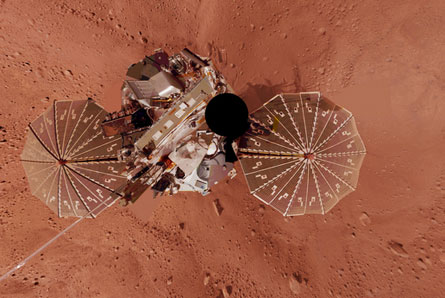New evidence suggests that Mars was much more active in the relatively recent past, with volcanoes erupting and water flowing on its surface within the past 100 million years.

The findings are based on the most precise measurements ever taken of carbon dioxide in the Martian atmosphere, recorded by NASA’s Mars Phoenix Lander during its five months of operation in 2008. Because carbon dioxide gas reacts strongly with both water and silicate rock, measuring the relative proportions of different isotopes of carbon and oxygen in the Martian atmosphere provides a record of the history of both materials on the planet. Paul Niles of NASA’s Johnson Space Center in Houston and his colleagues report the findings in the September 10 Science.
The carbon dioxide measurements “may be the most profound result to come out of the Phoenix mission,” comments Bruce Jakosky of the University of Colorado in Boulder, who was not involved in the study.
Over time, carbon dioxide exits the Martian atmosphere because the planet’s low gravity and small magnetic field can’t provide a strong enough anchor. During this process, the lighter carbon isotope, carbon-12, in the carbon dioxide escapes more quickly than the heavier isotope, carbon-13, and the ratio of carbon-12 to carbon-13 diminishes. Yet Phoenix found that the relative proportion of carbon-12 to carbon-13 was not smaller, as if the supply of carbon dioxide now in the Martian atmosphere is too new to have begun floating away into space.
The finding suggests that Mars continually replenishes the carbon dioxide it loses with fresh material. The most likely source is carbon dioxide belched during volcanic eruptions, Niles and his team say. If the researchers are correct, then volcanic activity has been significant on Mars during the past 100 million years, the time scale over which carbon dioxide naturally exits the atmosphere, Niles and his colleagues estimate.
“This is a surprise because many people think Mars has had very little geologic activity in the past billion years,” says Niles.
But some scientists are skeptical that the result has as much bearing on the Red Planet’s recent history as the team claims.
“Their conclusion about replenishment of the atmosphere is probably correct,” Jakosky says. But the timescale could be much longer, the last 2 billion years rather than 100 million, he adds.
Phoenix also measured the relative abundances of the isotopes oxygen-16 and oxygen-18 in the carbon dioxide. In a fresh supply of carbon dioxide, the ratio of the two oxygen isotopes has a fixed value. But Phoenix found an enrichment of the oxygen-18 isotope relative to its lighter partner.
Niles’ team suggests that liquid water is the culprit, because its reaction with carbon dioxide can enrich the gas with oxygen-18. When carbon dioxide gas dissolves in water, it forms bicarbonate. The bicarbonate snares oxygen from the water and then cycles back into carbon dioxide gas, a process that repeats many times a minute, Niles explains. Carbon dioxide gas happens to hold onto the oxygen-18 isotope better than liquid water can. As a result, when carbon dioxide and water react, the carbon dioxide will become steadily richer in oxygen-18.
“This is a quantifiable effect, and we see it in the carbon dioxide on Mars,” says Niles. “This means that liquid water has been present on the surface of Mars in the recent geological past — the last 100 million years or so” and that water activity is still ongoing.
Jakosky says he’s not convinced that their conclusion about liquid water is correct. “They assume that the isotopes are set by interaction with liquid water, and then show that the results are consistent,” but many other processes can also alter the isotope ratios.
Even if the researchers’ assessment is correct, it’s uncertain if the water could have provided a niche for recent life on the Red Planet, which is now cold and dry.
At the upcoming winter meeting of the American Geophysical Union in San Francisco, Niles and Joseph Michalski of the Planetary Science Institute in Tucson and the Institut d’Astrophysique Spatiale in Paris will present their analysis of rocks exhumed from about 6 kilometers below the Martian surface by a meteor impact. The team finds that the buried rocks contain minerals — carbonates and phyllosilicates — that form only in the presence of liquid water.







